Real-Time Road Intersection Detection in Sparse Point Cloud Based on Augmented Viewpoints Beam Model
Abstract
:1. Introduction
- (1)
- We propose an augmented viewpoints beam model and design a real-time intersection detection method based on the model. Experiments on VLP-16 and HDL-64 lidar data show that the algorithm works well in real traffic conditions.
- (2)
- We design online evaluation metrics to evaluate the quality of the intersection detection results. It enables the UGV to self-assess the quality of the intersection detection in real time during moving.
- (3)
- We have collected and annotated a VLP-16 point cloud dataset specifically for intersections on our UGV, called NCP-Intersection. The dataset is publicly available at https://github.com/GetsonHu/NCP-Intersection.git (accessed on 15 August 2023).
2. Method
2.1. Preprocessing
2.2. Augmented Viewpoints Beam Model-Based Intersection Bifurcation Detection
| Algorithm 1 Intersection bifurcation detection |
| Require: point cloud set P Ensure: bifurcation angle set
|
2.2.1. Grid Map-Based Single-Viewpoint Beam Model
2.2.2. Augmented Viewpoints Beam Model
2.3. Determining Intersection Center
2.4. Confidence Evaluation
2.4.1. The Number of Bifurcations
2.4.2. The Angle of Bifurcations
2.4.3. Intersection Location Matching
3. Experiments
3.1. Experimental Data and Environment
3.2. Ablation Study of Parameters
3.3. Results and Analysis
4. Conclusions
Author Contributions
Funding
Institutional Review Board Statement
Informed Consent Statement
Data Availability Statement
Conflicts of Interest
References
- Tang, H.; Wu, T.; Dai, B. SmogNet: A point cloud smog segmentation network for unmanned vehicles. In Proceedings of the 2021 5th CAA International Conference on Vehicular Control and Intelligence (CVCI), Tianjin, China, 29–31 October 2021; IEEE: Piscataway, NJ, USA, 2021; pp. 1–6. [Google Scholar]
- Watanabe, T.; Matsutani, K.; Adachi, M.; Oki, T.; Miyamoto, R. Feasibility study of intersection detection and recognition using a single shot image for robot navigation. J. Image Graph. 2021, 9, 39–44. [Google Scholar] [CrossRef]
- Huang, X.; He, P.; Rangarajan, A.; Ranka, S. Intelligent intersection: Two-stream convolutional networks for real-time near-accident detection in traffic video. ACM Trans. Spat. Algorithms Syst. (TSAS) 2020, 6, 1–28. [Google Scholar] [CrossRef]
- Ahn, J.; Lee, Y.; Kim, M.; Park, J. Vision-based branch road detection for intersection navigation in unstructured environment using multi-task network. J. Adv. Transp. 2022, 2022, 9328398. [Google Scholar] [CrossRef]
- Chen, M.; Yan, W.; Feng, Y.; Wang, S.; Liang, Q. Large-Scale Underground Mine Positioning and Mapping with LiDAR-Based Semantic Intersection Detection. Min. Metall. Explor. 2023, 40, 2007–2021. [Google Scholar] [CrossRef]
- Zhao, Z.; Fu, H.; Ren, R.; Sun, Z. Real-Time Intersection Detection Based on Satellite Image and 3D LIDAR Point Cloud. In International Conference on Autonomous Unmanned Systems, Proceedings of the 2021 International Conference on Autonomous Unmanned Systems (ICAUS 2021); Wu, M., Niu, Y., Gu, M., Cheng, J., Eds.; Springer: Singapore, 2022; pp. 2868–2878. [Google Scholar]
- Chen, T.; Dai, B.; Liu, D.; Liu, Z. Lidar-based long range road intersection detection. In Proceedings of the 2011 Sixth International Conference on Image and Graphics, Hefei, China, 12–15 August 2011; IEEE: Piscataway, NJ, USA, 2011; pp. 754–759. [Google Scholar]
- Zhu, Q.; Chen, L.; Li, Q.; Li, M.; Nüchter, A.; Wang, J. 3d lidar point cloud based intersection recognition for autonomous driving. In Proceedings of the 2012 IEEE Intelligent Vehicles Symposium, Madrid, Spain, 3–7 June 2012; IEEE: Piscataway, NJ, USA, 2012; pp. 456–461. [Google Scholar]
- Zhang, Y.; Wang, J.; Wang, X.; Li, C.; Wang, L. 3D lidar-based intersection recognition and road boundary detection method for unmanned ground vehicle. In Proceedings of the 2015 IEEE 18th International Conference on Intelligent Transportation Systems, Gran Canaria, Spain, 15–18 September 2015; IEEE: Piscataway, NJ, USA, 2015; pp. 499–504. [Google Scholar]
- Zhang, Y.; Wang, J.; Wang, X.; Dolan, J.M. Road-Segmentation-Based Curb Detection Method for Self-Driving via a 3D-LiDAR Sensor. IEEE Trans. Intell. Transp. Syst. 2018, 19, 3981–3991. [Google Scholar] [CrossRef]
- Wang, G.; Wu, J.; He, R.; Tian, B. Speed and Accuracy Tradeoff for LiDAR Data Based Road Boundary Detection. IEEE/CAA J. Autom. Sin. 2021, 8, 1210–1220. [Google Scholar] [CrossRef]
- Hata, A.Y.; Habermann, D.; Osorio, F.S.; Wolf, D.F. Road geometry classification using ANN. In Proceedings of the 2014 IEEE Intelligent Vehicles Symposium Proceedings, Dearborn, MI, USA, 8–11 June 2014; IEEE: Piscataway, NJ, USA, 2014; pp. 1319–1324. [Google Scholar]
- Chen, X.; Xiang, L.; Jiao, F.; Wu, H. Detecting Turning Relationships and Time Restrictions of OSM Road Intersections from Crowdsourced Trajectories. ISPRS Int. J.-Geo-Inf. 2023, 12, 372. [Google Scholar] [CrossRef]
- Wang, Y.; Sun, Y.; Liu, Z.; Sarma, S.E.; Bronstein, M.M.; Solomon, J.M. Dynamic graph cnn for learning on point clouds. ACM Trans. Graph. (TOG) 2019, 38, 1–12. [Google Scholar] [CrossRef]
- Du, J.; Liu, X.; Meng, C. Road Intersection Extraction Based on Low-Frequency Vehicle Trajectory Data. Sustainability 2023, 15, 14299. [Google Scholar] [CrossRef]
- Eltaher, F.; Taha, A.; Courtney, J.; Mckeever, S. Using Satellite Images Datasets for Road Intersection Detection in Route Planning. Int. J. Comput. Syst. Eng. 2022, 16, 411–418. [Google Scholar]
- Li, C.; Cong, R.; Kwong, S.; Hou, J.; Fu, H.; Zhu, G.; Zhang, D.; Huang, Q. ASIF-Net: Attention steered interweave fusion network for RGB-D salient object detection. IEEE Trans. Cybern. 2020, 51, 88–100. [Google Scholar] [CrossRef] [PubMed]
- Zhao, W.; Li, C.; Zhang, W.; Yang, L.; Zhuang, P.; Li, L.; Fan, K.; Yang, H. Embedding global contrastive and local location in self-supervised learning. IEEE Trans. Circuits Syst. Video Technol. 2022, 33, 2275–2289. [Google Scholar] [CrossRef]
- Zhang, W.; Li, Z.; Sun, H.-H.; Zhang, Q.; Zhuang, P.; Li, C. SSTNet: Spatial, Spectral, and Texture Aware Attention Network Using Hyperspectral Image for Corn Variety Identification. IEEE Geosci. Remote Sens. Lett. 2022, 19, 1–5. [Google Scholar] [CrossRef]
- Thrun, S.; Montemerlo, M. The graph SLAM algorithm with applications to large-scale mapping of urban structures. Int. J. Robot. Res. 2006, 25, 403–429. [Google Scholar] [CrossRef]
- Sun, P.; Zhao, X.; Xu, Z.; Wang, R.; Min, H. A 3D LiDAR data-based dedicated road boundary detection algorithm for autonomous vehicles. IEEE Access 2019, 7, 29623–29638. [Google Scholar] [CrossRef]
- Wang, L.; Zhang, Y.; Wang, J. Map-based localization method for autonomous vehicles using 3D-LIDAR. IFAC-PapersOnLine 2017, 50, 276–281. [Google Scholar] [CrossRef]
- Rozenberszki, D.; Majdik, A.L. LOL: Lidar-only Odometry and Localization in 3D point cloud maps. In Proceedings of the 2020 IEEE International Conference on Robotics and Automation (ICRA), Paris, France, 31 May–31 August 2020; pp. 4379–4385. [Google Scholar] [CrossRef]
- Omeiza, D.; Webb, H.; Jirotka, M.; Kunze, L. Explanations in autonomous driving: A survey. IEEE Trans. Intell. Transp. Syst. 2021, 23, 10142–10162. [Google Scholar] [CrossRef]
- Fischler, M.A.; Bolles, R.C. Random Sample Consensus: A Paradigm for Model Fitting with Applications to Image Analysis and Automated Cartography. Commun. ACM 1981, 24, 381–395. [Google Scholar] [CrossRef]
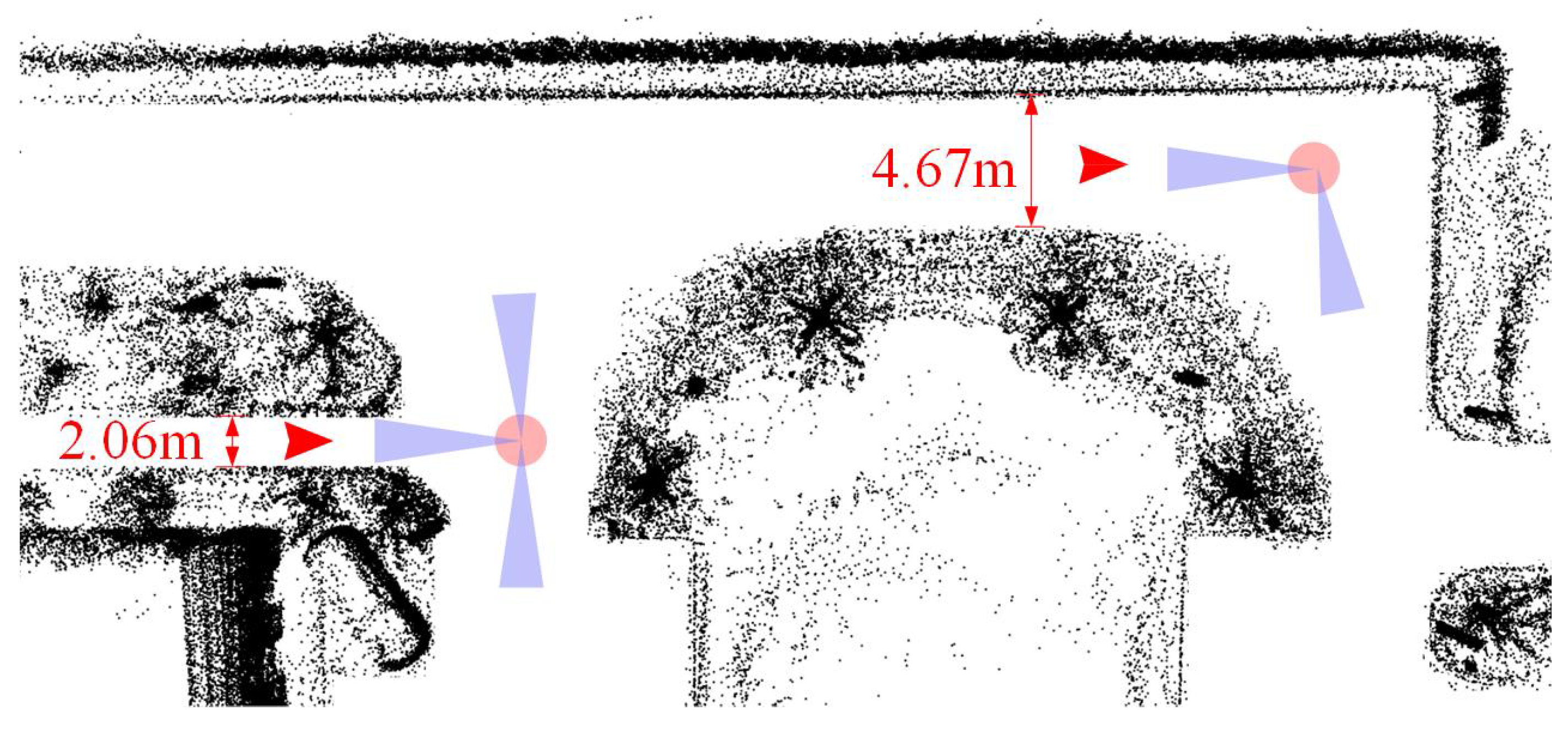
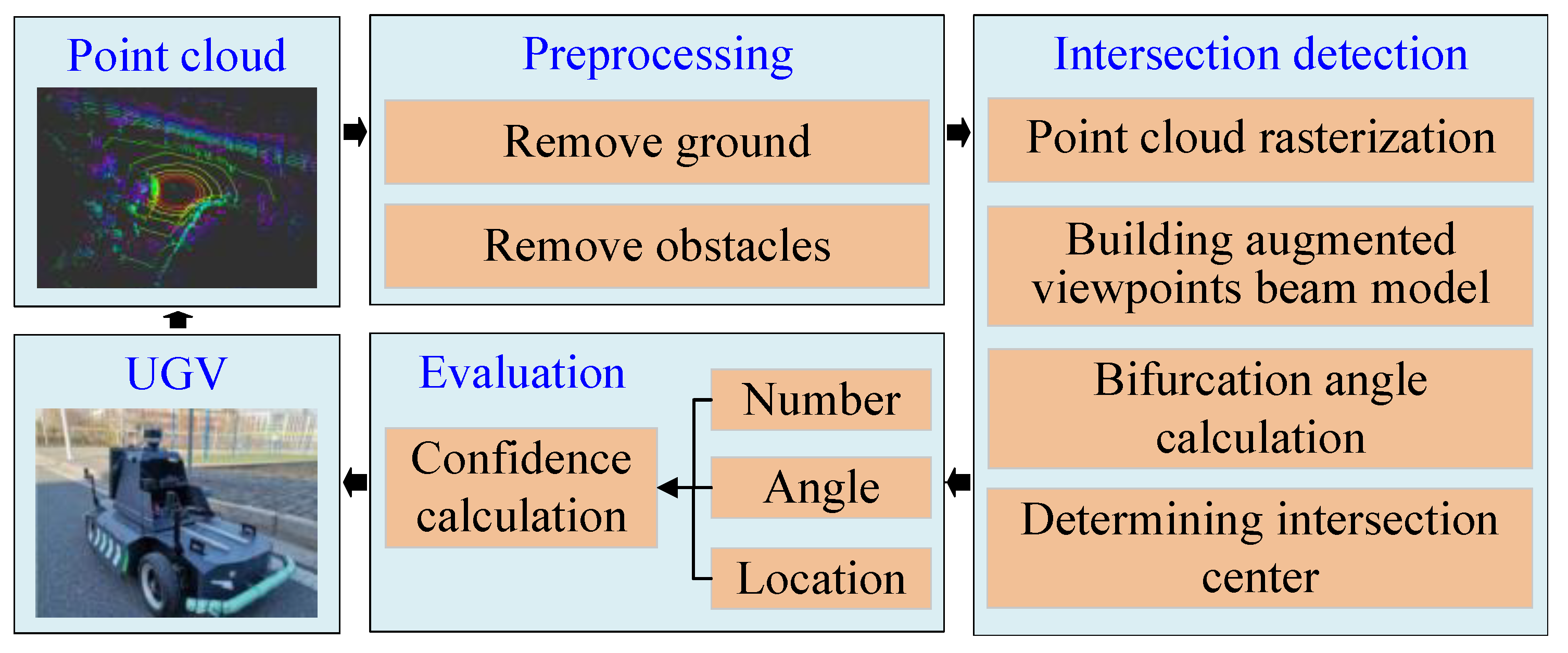
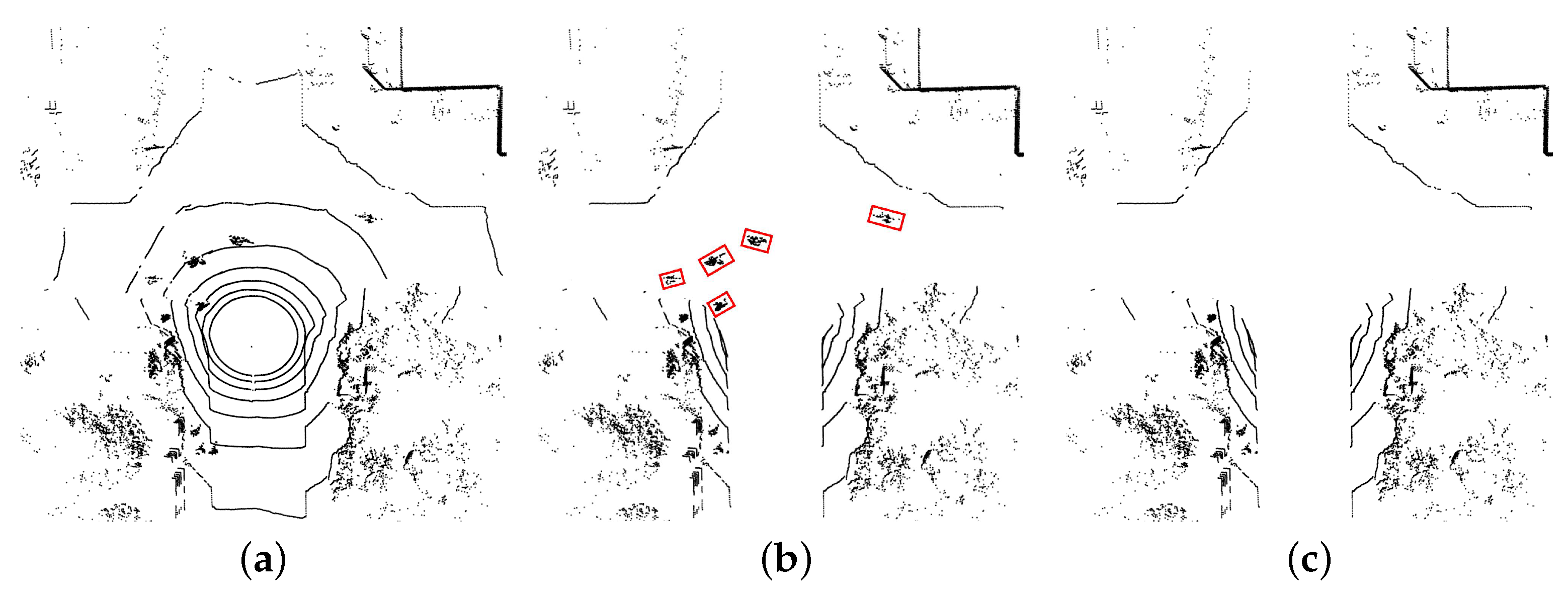
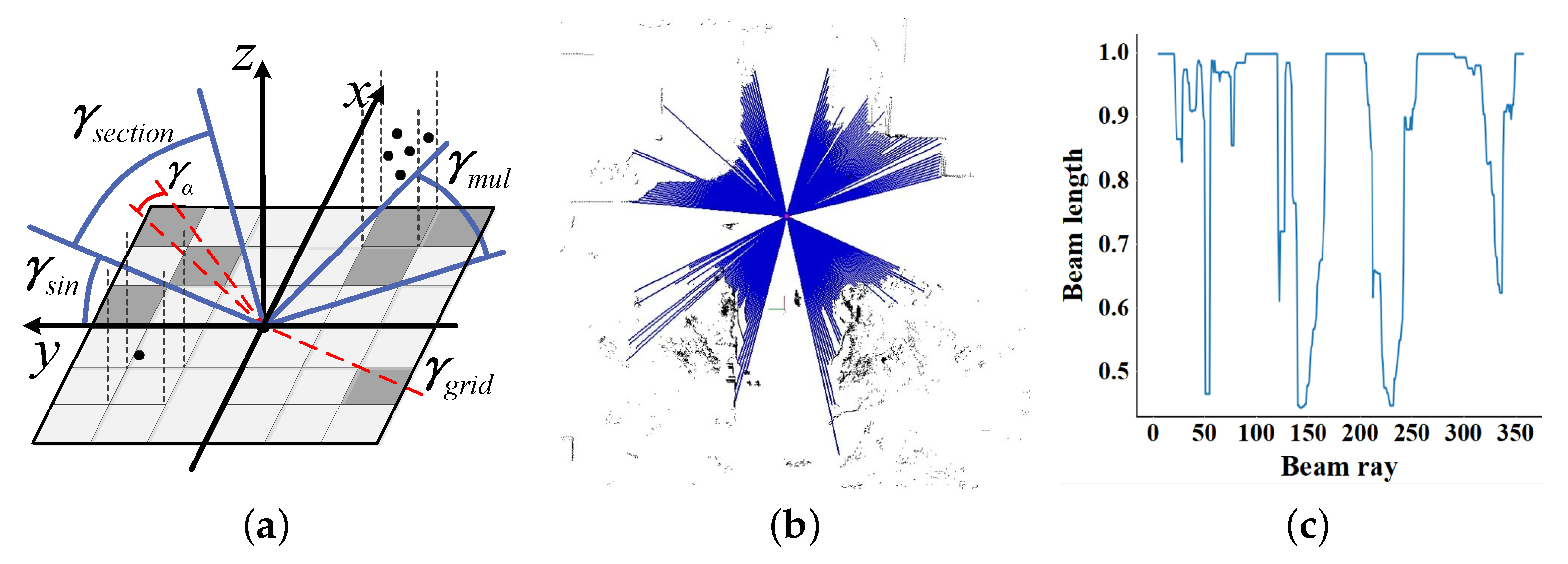
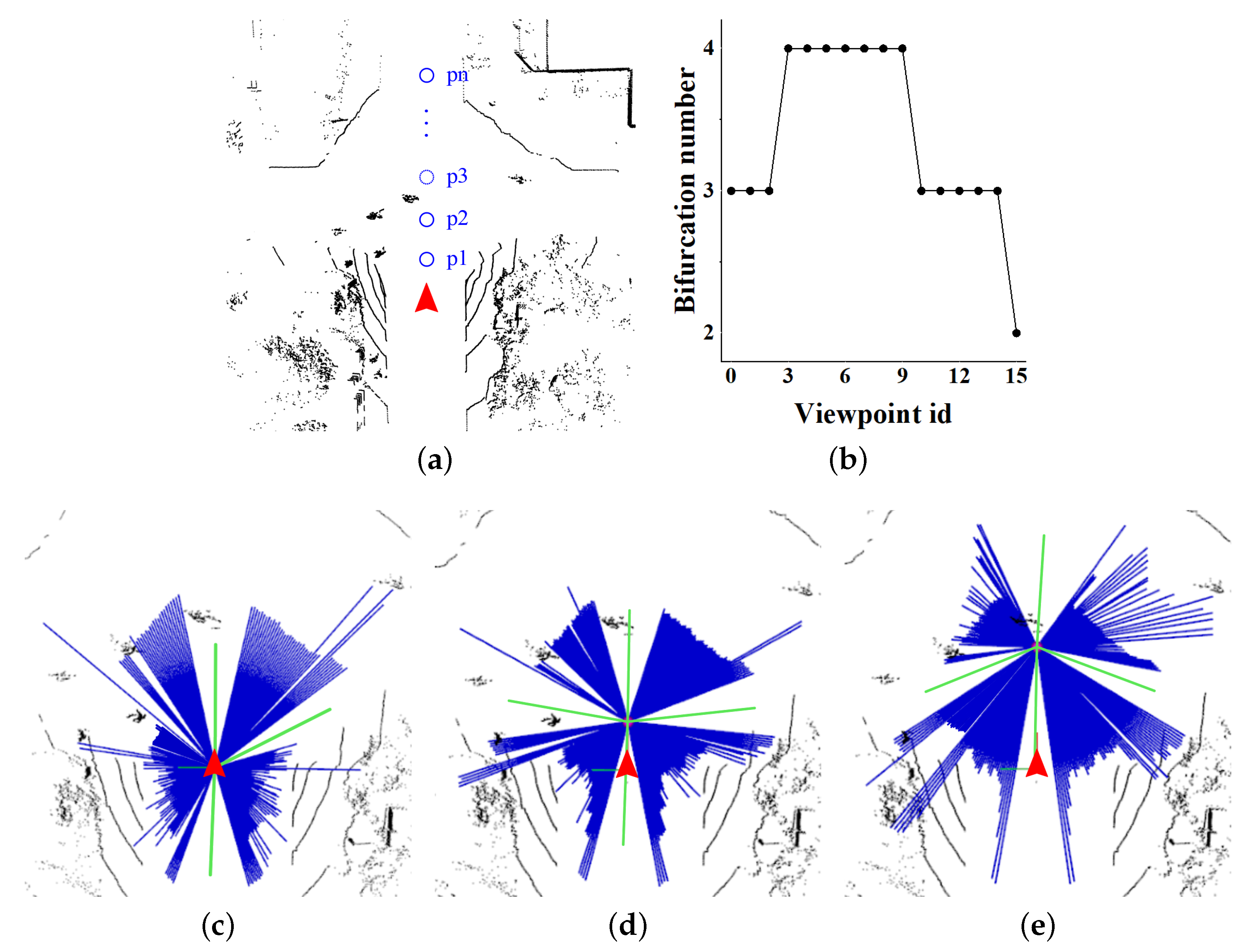
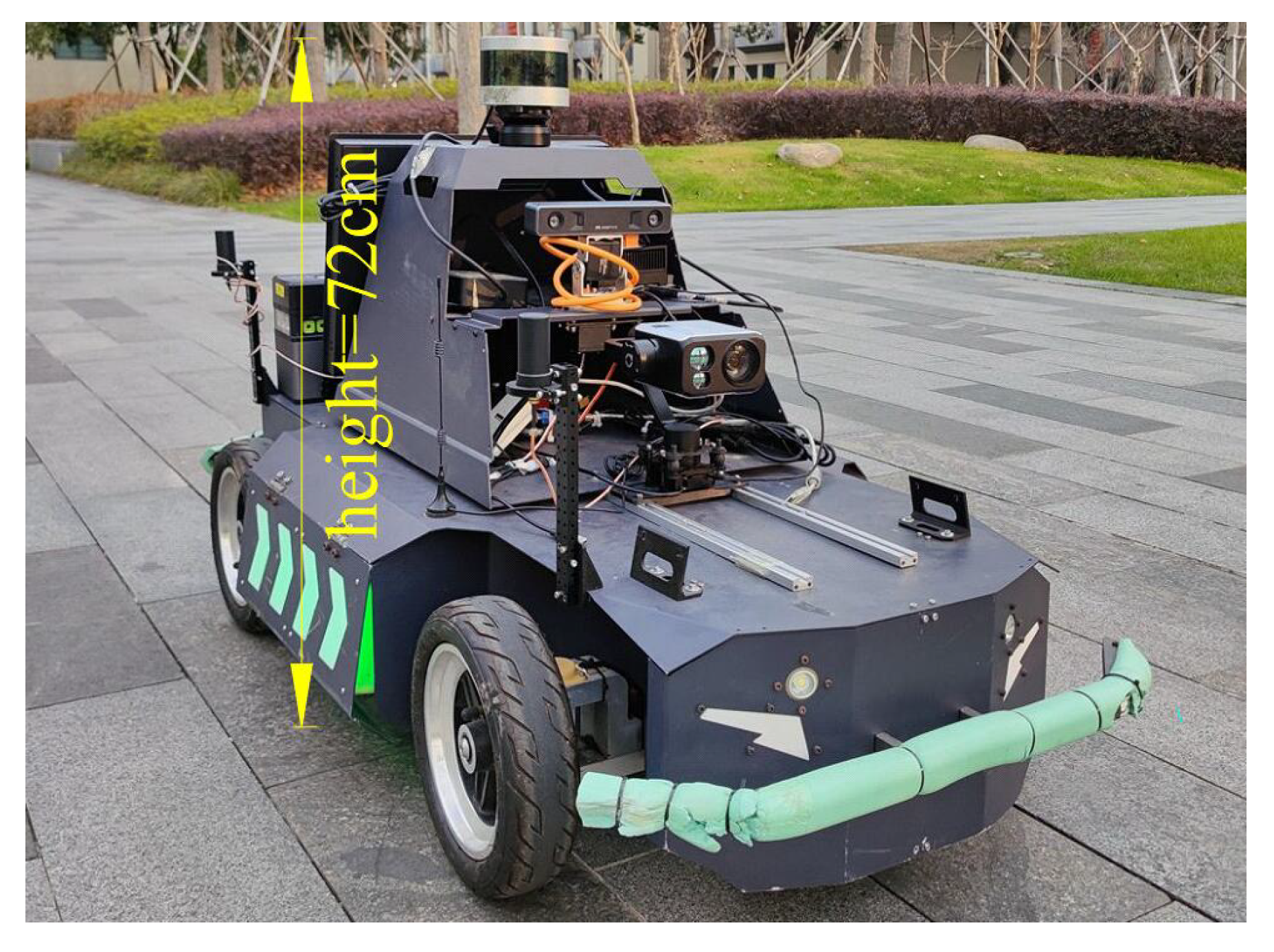
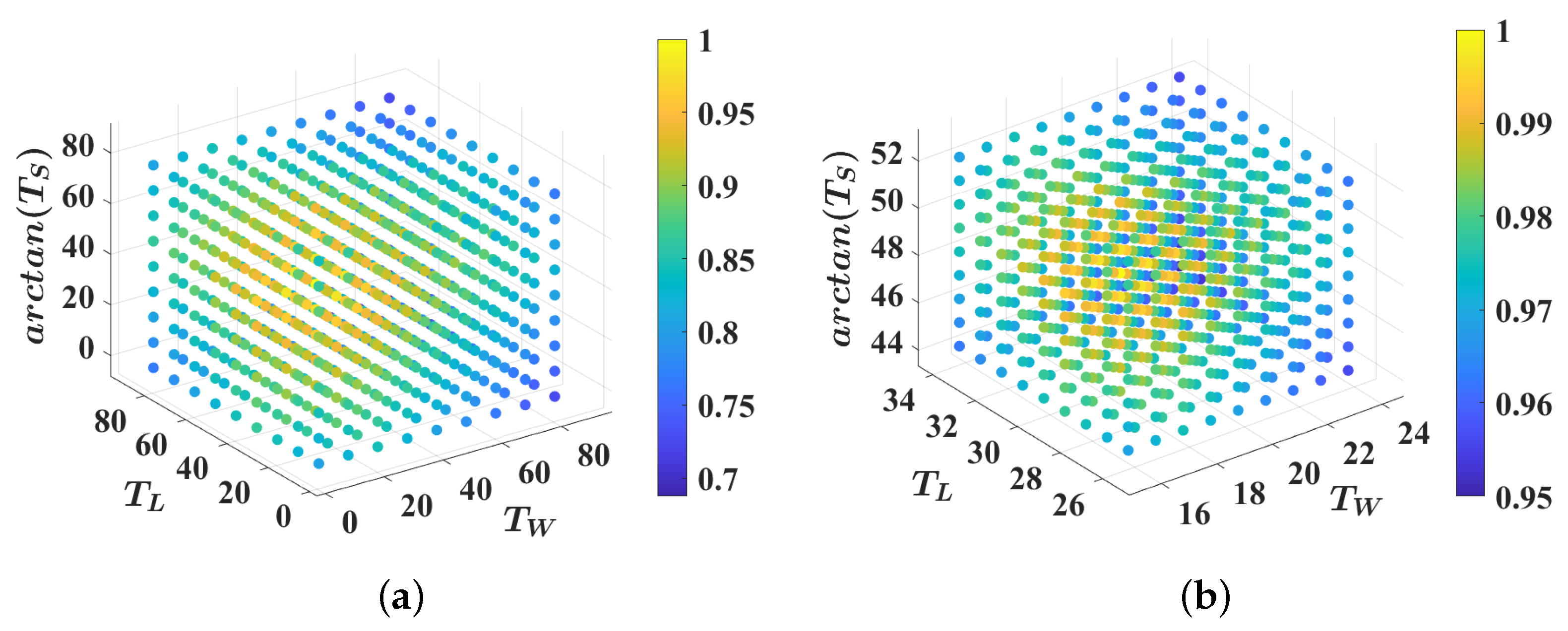
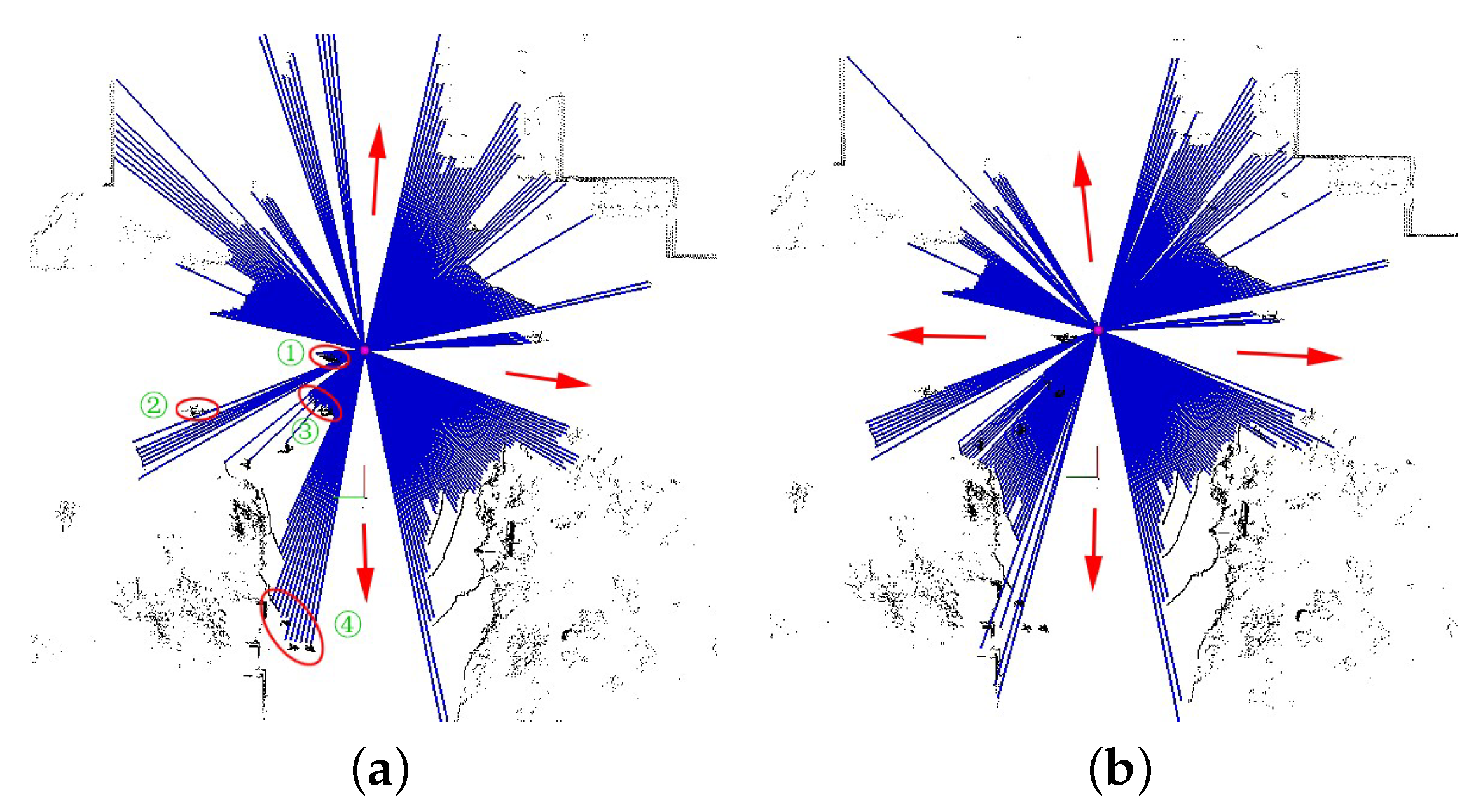
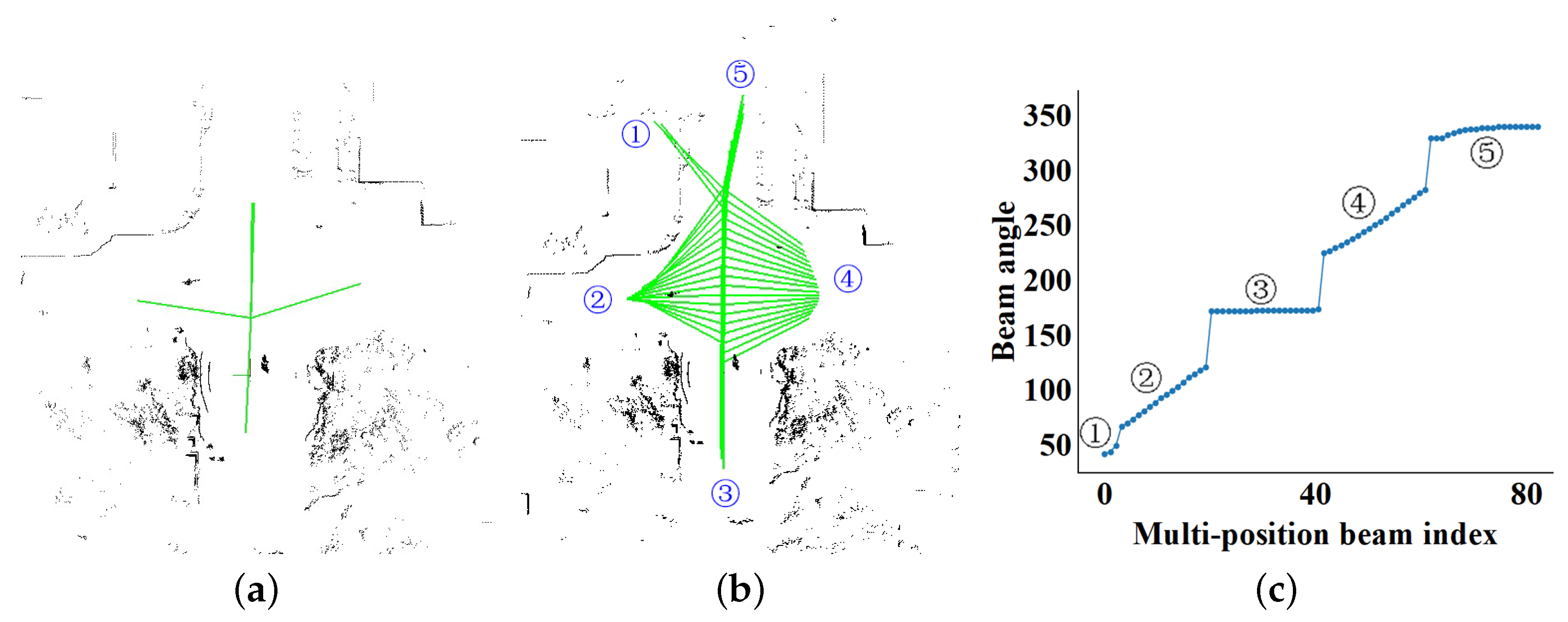
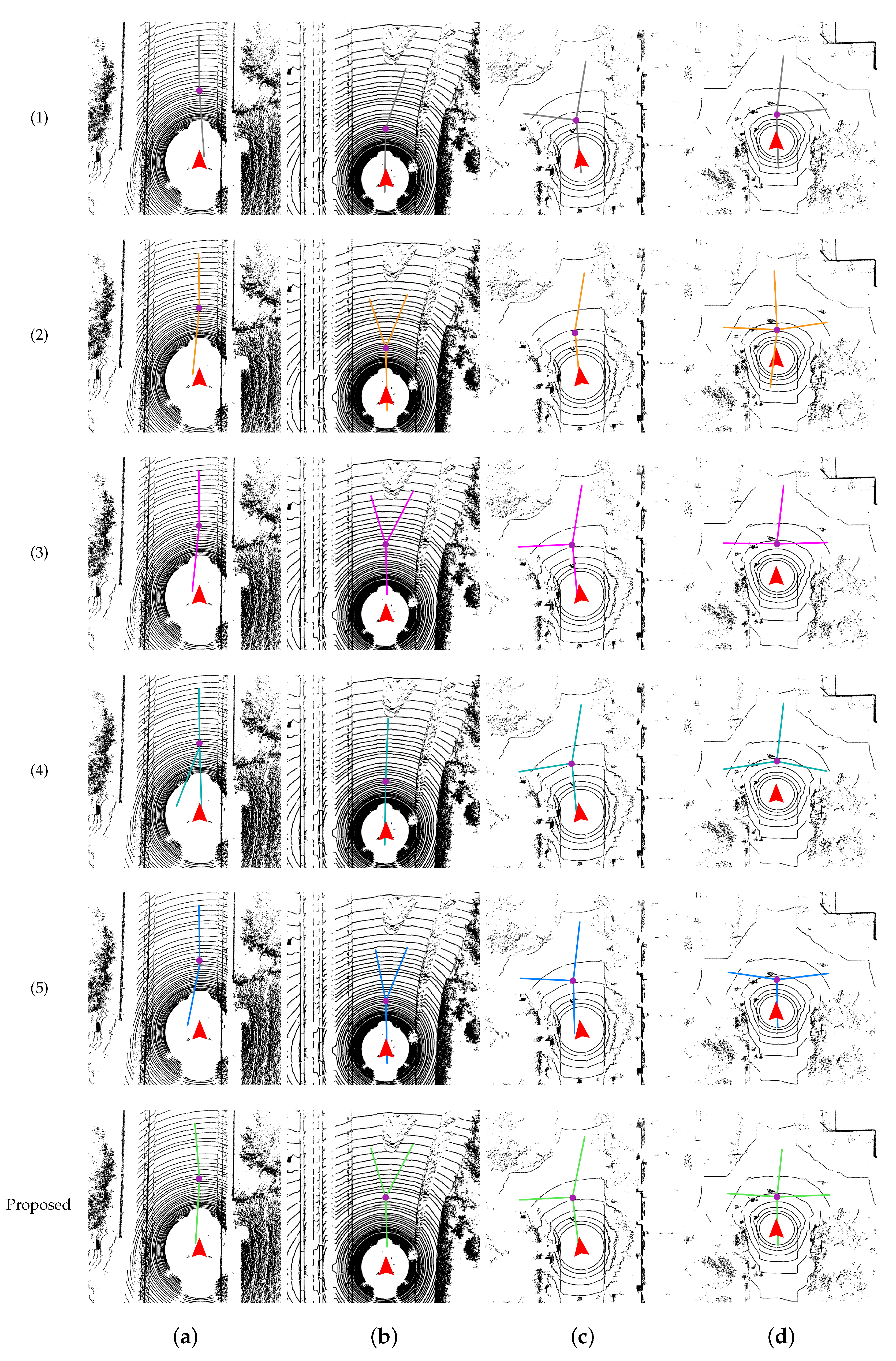

| 0.9780 | 0.9813 | 0.9844 | 0.9832 | 0.9818 | ||
| 0.9834 | 0.9855 | 0.9895 | 0.9876 | 0.9861 | ||
| 0.9872 | 0.9889 | 0.9931 | 0.9917 | 0.9891 | ||
| 0.9905 | 0.9958 | 0.9987 | 0.9941 | 0.9923 | ||
| 0.9842 | 0.9945 | 0.9963 | 0.9932 | 0.9895 | ||
| 0.9873 | 1.0000 | 1.0000 | 1.0000 | 0.9923 | ||
| 0.9858 | 0.9986 | 1.0000 | 1.0000 | 0.9902 | ||
| 0.9841 | 0.9918 | 0.9959 | 0.9940 | 0.9897 | ||
| 0.9813 | 0.9842 | 0.9933 | 0.9897 | 0.9822 | ||
| 0.9841 | 0.9956 | 1.0000 | 0.9935 | 0.9864 | ||
| 0.9867 | 0.9902 | 0.9945 | 0.9879 | 0.9823 | ||
| 0.9822 | 0.9884 | 0.9902 | 0.9843 | 0.9786 |
| Dataset | Method | Running Time (ms)↓ | Dist (m)↑ | ISR↑ | LFR↓ | TPR↑ | PPV↑ | ↑ | |
|---|---|---|---|---|---|---|---|---|---|
| on x86 | on ARM | ||||||||
| KITTI-raw | Zhu [8] | 232 | 349 | 4.5 | 0.6146 | 0.4223 | 0.6329 | 0.6602 | 0.6463 |
| Chen [7] | 298 | 412 | 5.0 | 0.6786 | 0.4820 | 0.6687 | 0.6823 | 0.6754 | |
| Zhang [9] | 382 | 686 | 6.5 | 0.7233 | 0.4156 | 0.7045 | 0.7298 | 0.7169 | |
| Zhang [10] | 739 | 996 | 7.5 | 0.8483 | 0.4409 | 0.7341 | 0.7563 | 0.7450 | |
| Wang [11] | 118 | 218 | 6.0 | 0.5513 | 0.7180 | 0.6231 | 0.6472 | 0.6349 | |
| Proposed | 112 | 201 | 8.5 | 0.9231 | 0.1205 | 0.8217 | 0.8486 | 0.8349 | |
| NCP- Intersection | Zhu [8] | 158 | 245 | 4.5 | 0.5987 | 0.4102 | 0.6163 | 0.6299 | 0.6230 |
| Chen [7] | 196 | 281 | 5.0 | 0.6525 | 0.4657 | 0.6472 | 0.6701 | 0.6585 | |
| Zhang [9] | 249 | 423 | 6.5 | 0.7019 | 0.3782 | 0.6829 | 0.7133 | 0.6978 | |
| Zhang [10] | 136 | 218 | 7.5 | 0.8087 | 0.4213 | 0.7938 | 0.8212 | 0.8073 | |
| Wang [11] | 82 | 138 | 6.0 | 0.5870 | 0.7483 | 0.6958 | 0.7119 | 0.7038 | |
| Proposed | 88 | 158 | 8.5 | 0.9180 | 0.1324 | 0.8548 | 0.8836 | 0.8690 | |
| Simulation | Zhu [8] | 154 | 231 | 4.5 | 0.6057 | 0.4068 | 0.6241 | 0.6487 | 0.6362 |
| Chen [7] | 201 | 287 | 5.0 | 0.6621 | 0.4544 | 0.6524 | 0.6813 | 0.6665 | |
| Zhang [9] | 246 | 417 | 6.5 | 0.7134 | 0.3675 | 0.6786 | 0.7012 | 0.6897 | |
| Zhang [10] | 138 | 223 | 7.5 | 0.8147 | 0.4398 | 0.8217 | 0.8459 | 0.8336 | |
| Wang [11] | 84 | 145 | 6.0 | 0.5919 | 0.7462 | 0.7125 | 0.7289 | 0.7206 | |
| Proposed | 90 | 153 | 8.5 | 0.9147 | 0.1313 | 0.8856 | 0.9037 | 0.8946 | |
Disclaimer/Publisher’s Note: The statements, opinions and data contained in all publications are solely those of the individual author(s) and contributor(s) and not of MDPI and/or the editor(s). MDPI and/or the editor(s) disclaim responsibility for any injury to people or property resulting from any ideas, methods, instructions or products referred to in the content. |
© 2023 by the authors. Licensee MDPI, Basel, Switzerland. This article is an open access article distributed under the terms and conditions of the Creative Commons Attribution (CC BY) license (https://creativecommons.org/licenses/by/4.0/).
Share and Cite
Hu, D.; Zhang, K.; Yuan, X.; Xu, J.; Zhong, Y.; Zhao, C. Real-Time Road Intersection Detection in Sparse Point Cloud Based on Augmented Viewpoints Beam Model. Sensors 2023, 23, 8854. https://doi.org/10.3390/s23218854
Hu D, Zhang K, Yuan X, Xu J, Zhong Y, Zhao C. Real-Time Road Intersection Detection in Sparse Point Cloud Based on Augmented Viewpoints Beam Model. Sensors. 2023; 23(21):8854. https://doi.org/10.3390/s23218854
Chicago/Turabian StyleHu, Di, Kai Zhang, Xia Yuan, Jiachen Xu, Yipan Zhong, and Chunxia Zhao. 2023. "Real-Time Road Intersection Detection in Sparse Point Cloud Based on Augmented Viewpoints Beam Model" Sensors 23, no. 21: 8854. https://doi.org/10.3390/s23218854
APA StyleHu, D., Zhang, K., Yuan, X., Xu, J., Zhong, Y., & Zhao, C. (2023). Real-Time Road Intersection Detection in Sparse Point Cloud Based on Augmented Viewpoints Beam Model. Sensors, 23(21), 8854. https://doi.org/10.3390/s23218854





